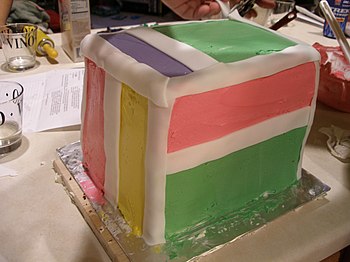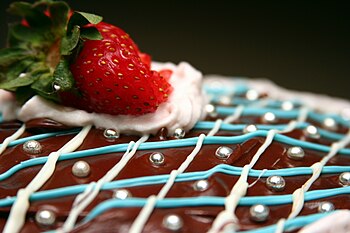
|
|
Birthday cake with hard white fondant icing as trim, framing soft,
colored buttercream frosting. (Photo credit: Wikipedia) |
1. Buttercream Icing: Buttercream is the icing that is used the most in cake decorating. This is the same type of frosting that we can buy readymade in the grocery store. This icing is easy to use and easy to make. The ingredients are confectioners sugar, and butter or shortening. What you use to thin the frosting will differ with the icing texture you need to work with, to determine whether to use eggs or milk. Take care when thinning the frosting,
remember, a little milk goes a long way. If you find the frosting is too thin,
you can add a bit of confectioners sugar to thicken it.
To assure an even finish on your frosting, dip the icing spatula in cold water to make the surface smooth. This will give a smoother finish for writing.
Buttercream is used to create flowers and other decorations made with a pastry bag. The icing needs to be the right consistency to make flower petals or writing. When you make roses out of icing, you can freeze them and add them to the cake later. This will make it easier to handle.
Buttercream can be stored in the refrigerator without getting hard. Make sure
it is back to room temperature before you attempt to use it.
2. Foam Icing: This is a meringue and is used on a lemon pie or Baked Alaska.
This frosting is made of egg whites beaten into stiff peaks. It is possible to add flavoring and color to the meringue. You will not be able to use this icing for intricate cake decorating, and you won't be able to use an icing bag with this icing. This icing is used when you want the cake to look fluffy,
with little ornate decoration.
3. Fondant: This icing is very popular with those who decorate wedding cakes, and cakes for very special occasions. The ingredients are simply powdered sugar, water,
cream of tartar, or glucose. Fondant is thick and doughy, with a silky,
smooth, texture. Fondant will give the cake a flawless surface, and soft,
rounded edges. Working with fondant is an art and will take practice to get it right. Fondant has a translucent quality and will work best when placed on the cake over a thin layer of buttercream frosting.
4. Fudge Icing: Fudge icing is made from chocolate, peanut butter, almond, or mint. This icing is quite thick and contains both shortening and butter.
5. Glazes: This frosting is thin and watery, and will harden into a shell after it is placed on the cake. This frosting is mostly used on pastries.
Glazes help to keep the pastry moist.
6. Flat Icing: This icing is similar to a glaze, but it is a bit thicker. Flat
icing is a combination of confectioner's sugar and water and is used to
drizzle onto pastries.
7. Royal Icing: This is also a flat icing, and hardens after it is set. Royal
icing is a wonderful choice to make flowers, sculptures, and garnishes for
cake decorating.
You can use any combination of the basic seven icings listed, to create a
personal masterpiece. You will need to practice before you become good at cake decorating.
You will get the hang of it sooner than you think, and even the mistakes will
taste great.




